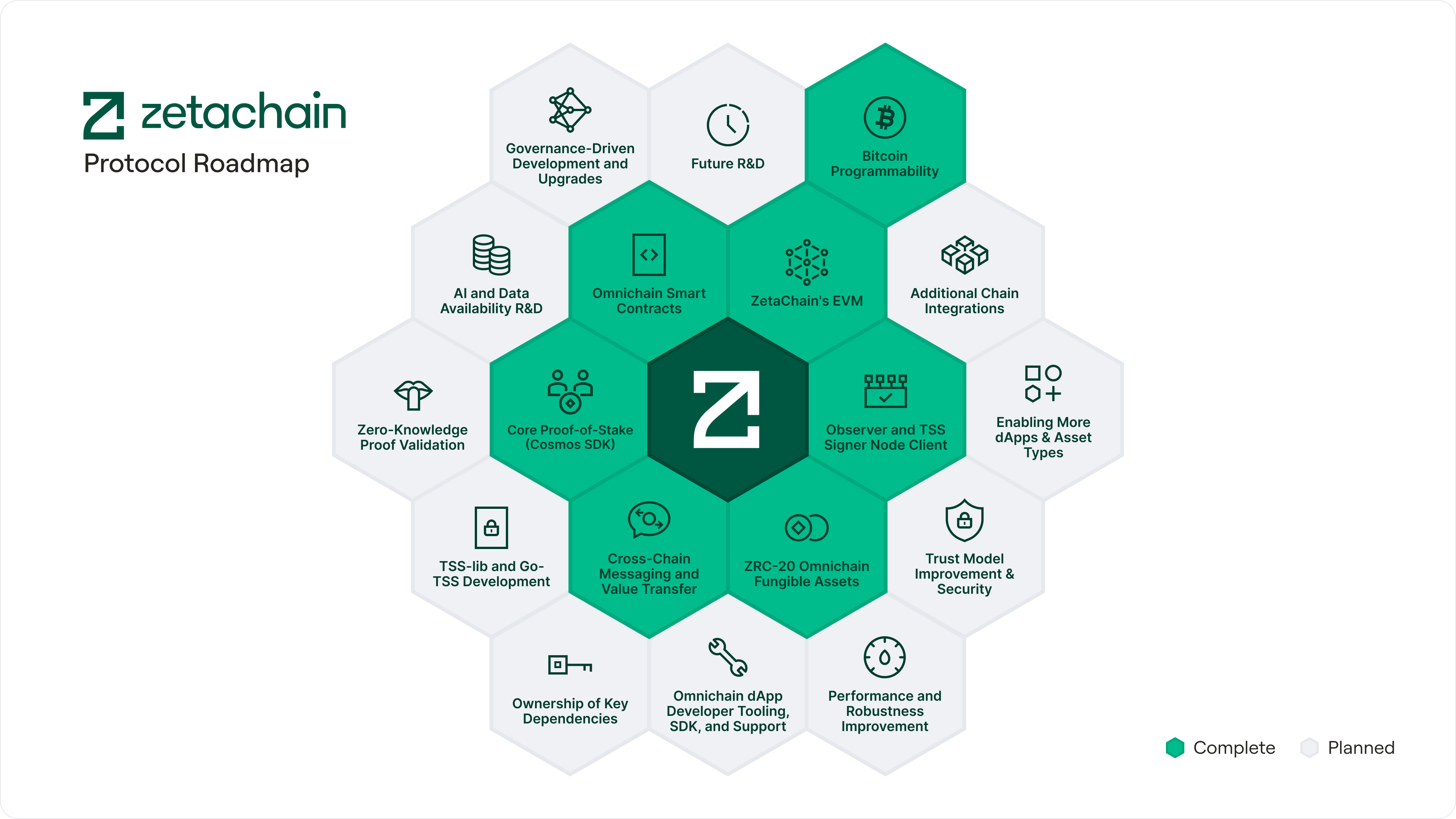Technical Roadmap
Overview
ZetaChain’s mission is to serve as a platform for universal access, simplicity, and utility across any blockchains. ZetaChain’s initial mainnet launch contains all core functionality contemplated within ZetaChain’s proposed features, including its EVM layer, omnichain smart contracts, and cross-chain messaging.
ZetaChain is a Proof-of-Stake blockchain designed for interoperability, supporting the creation of omnichain dApps that can span any chain, including the Bitcoin blockchain, where all transaction, incentives, data security, and cross-chain interaction requires ZETA tokens to function.
This document outlines the initial development directions that the protocol may take in order to improve and add onto the core functionality of the ZetaChain network, based on decentralized community input. All real development and upgrades will be done through governance, and development of the ZetaChain network is fully open-source — anybody can and should feel free to contribute to the development of the network. The community and contributors will drive the progress of the network.
Potential Key Development Roadmap Pillars

Here are the key pillars of planned areas of development.
Chain integrations
- Objective: Expand the ecosystem by integrating additional blockchain networks.
- Chains to Integrate: Chains such as Solana, Filecoin, Bitcoin ordinals/BRC20, Cosmos ecosystem via Inter-Blockchain Communication (IBC), various Layer 2 solutions (L2s), and others as determined by ecosystem needs.
- Approach: Develop and implement secure and efficient protocols for cross-chain interoperability. Improve framework and architecture for new chain integrations modularly.
- Expected Outcome: Increased network robustness and accessibility, attracting a wider user base.
- Challenges: Cryptography (TSS for signature schemes other than ECDSA secp256k1 curve), heterogeneous blockchain model/parameters/interaction methods, potential problems with source of information that may not be efficiently/robustly available from standard full-node, speed and cost of considerations in relation to spam deterrence.
More dApp, Asset, and Transaction Types
- Objective: Facilitate the creation and operation of diverse decentralized applications (dApps) and assets/standards.
- Key Features:
- Arbitrary omnichain smart contract messaging to/from ZetaChain.
- ZRC-20 whitelisting automation and expanded onboarding process.
- ZRC20-like NFT support for omnichain smart contracts.
- BRC20/Ordinals support in Omni-chain smart contracts.
- Standardized interactions with external chains beyond fungible tokens (ZRC20 model)— like NFTs (”ZRC721”?)
- Expected Outcome: A more vibrant and versatile ecosystem supporting a wider range of applications and assets that applications can orchestrate.
- Challenges: Secure, simple, and efficient way to compose and interoperate different assets/contracts, standards on different chains.
Trust Model Improvement & Security
- Objective: Enhance the trust model and security of the network.
- Strategies:
- Shift from observation of inbound and outbound transactions to a proof-verification-based model.
- Reduce reliance on the assumption of 2/3 honest observers for external events.
- Improve observer/tss signer on-chain monitoring and incentives
- Gradually increase decentralization and reduce central point of failures/control.
- Improve performance and reduce cost by utilizing zero-knowledge proof for validating external events/computations.
- Expected Outcome: Reduced operational costs, enhanced network security, and increased trustworthiness, and reduce single point of failure points.
- Challenges: Incentives, decentralization, and security.
Performance and Robustness Improvement
- Objective: Boost the network's efficiency and throughput.
- Key Areas:
- Higher cross-chain Transactions Per Second (TPS).
- Lower resource consumption and storage requirements for validators.
- Increase awareness of network operation, error/exception handling and recovery.
- Performance and chaos engineering tooling to battle-test new protocol upgrades.
- Expected Outcome: A faster, more efficient, and reliable blockchain network capable of handling increased transaction volumes.
- Challenges: understanding the bottleneck, scaling issues, and tradeoffs between performance/storage efficiency vs verifiability of the network.
Omnichain dApp Developer Tooling, SDK, and Support
- Objective: Provide superior tools and support to developers.
- Tools to Develop:
- JavaScript/TypeScript SDKs, Telegram Bot SDK
- Debugging tools.
- Cross-chain transaction simulation.
- Explorer/observability: especially better support for complex cross-chain dApps to expose the cross-chain sub-tx in an easy to understand way.
- Expected Outcome: Easier development process, leading to an influx of high-quality and more novel dApps.
- Challenges: understanding of dApp/frontend needs; diverse requirements and preferences from developers.
Taking Ownership of Key Dependencies
- Objective: Improve key open-source dependencies.
- Areas of Focus:
- Ethermint: Enhance compatibility with Ethereum tooling, efficiency, and interoperability with EVM and Cosmos modules.
- TSS-lib & Go-TSS: Improve security, performance, and support for new signature schemes and chains.
- Expected Outcome: A more reliable and versatile ecosystem, facilitating smoother operations and integration. A growing community of open source contributors for each projects.
- Challenges: large code base to develop and maintain, upstreaming strategy and working with other teams that share substantial amount of code.